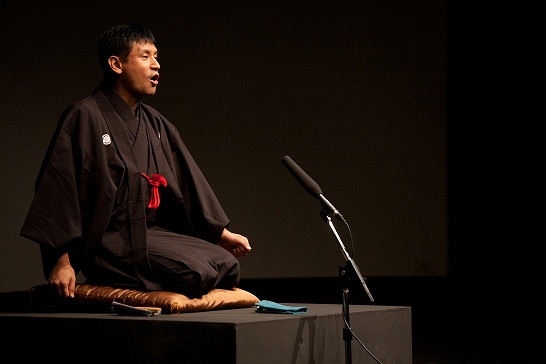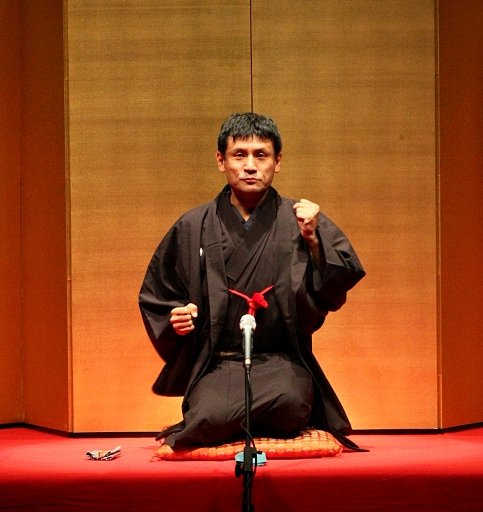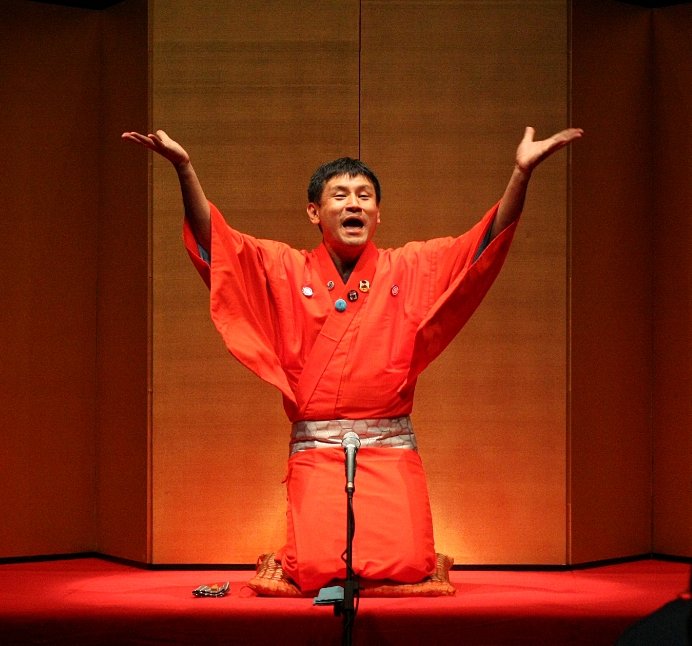Rakugo : Traditional Japanese Comedy Performance
Program
- Introduction of program by organizer
- ACT 1 “Tokisoba”
- Intermission <5 min.>
- ACT 2 “Gonsuke Zakana”
- Introduction of Jugemu by organizer
- Playing DVD “Jugemu”
- ACT 3 “Waraidake” and “Atamayama”

| 1 | Date : | 13th November |
|---|---|---|
Time : | 11:00 - 12:30 hrs. | |
Venue : | Somaiya Institute of Management Research Studies, Mumbai | |
|
Auditorium, 4th Floor, Somaiya Institute of Management Research Studies, S.I.S.M.R. Building, Vidyavihar (East), Mumbai
Map (Google Map) |
||
Contact : | Ms. Sarita Sundaram TEL : 98-2034-0608 | |
| 2 | Date : | 13th November |
|---|---|---|
Time : | 17:00 - 18:30 hrs. | |
Venue : | The K. R. Cama Oriental Institute, Mumbai | |
|
The K. R. Cama Oriental Institute, 136, Bombay Samachar Marg, Opposite Lion Gate, Fort,Mumbai 400 023
Map (Google Map) |
||
Contact : | Ms. Sarita Sundaram TEL : 98-2034-0608 | |
| 3 | Date : |
14th November |
|---|---|---|
Time : | 12:00 - 13:30 hrs. | |
Venue : | Birla College, Thane | |
|
New Seminar Hall, 1st Floor, IT Building, Birla College, Kalyan West, Dist. Thane
Map (Google Map) |
||
Contact : | Ms. Kavita Bam TEL : 98-1922-4502 | |
| 4 | Date : | 15th November |
|---|---|---|
Time : | 11:00 - 12:30 hrs. | |
Venue : | Tilak Smarak Mandir, Pune | |
|
Tilak Smarak Mandir, 1651, Sadashiv Peth, Tilak Road, Near S.P. College,Pune 411 030
Map (Google Map) |
||
Contact : | Mr. Vinay Sathe TEL : 91-5825-1347 | |
| 5 | Date : | 15th November |
|---|---|---|
Time : | 19:00 - 20:30 | |
Venue : | Symbiosis Institute, Pune | |
|
Main Hall, Symbiosis Institute, Senapati Bapat Road,Pune 411 016
Map (Google Map) |
||
Contact : | Mr. Ramesh Divekar TEL : 94-2350-7458 | |
Entry to all events is free.
Rakugo
Rakugo is Japanese humourous approach to fundamental human experiences. It is the art of imagination and the audience is free to imagine features and background of culture.
The roots of Rakugo can be traced to the end of 17th century. The style of the performance or presentation was established in the late 18th century and has not changed. Rakugo stories were intended to teach what would be laughed in the society and give people social knowledge. As it developed and became entertainment for common people, the rooms (Yose) where Rakugo was performed became centers for social gathering.
Rakugo-Ka who is performer of rakugo sits down on a cushion in the middle of the stage and tries to capture the audience imagination with facial expressions and funny stories. The performer is usually equipped with a fan (Sensu) and hand towel (Tenugui). These items help the performer to express and act out the story. For example, the fan can be chopsticks, scissors, cigarettes, pipe, or pen. The towel could be a book, bills, or an actual towel.
One of the differences from comedy in the western is the style of play. They are sit-down comedy of comic storytelling, as there is stand-up comedy in the western countries. The performer sits on his knees when he performs, so it requires some training to sit like that for a long time without letting the legs fall in sleep. The performer wears traditional formal Japanese clothes (Kimono) and sometimes wears a pair of long wide pants (Hakama) and/or a formal jacket (Haori).
Another point is that one performer plays the role of each distinct character by himself. There are always several characters in a Rakugo story. The performer plays each character by changing voice, facial expression, mannerisms, speech etc. In most cases, the characters have strong stereotypical personalities and characteristics so that as the performer switches from one character to another, the audience readily detects the change. There are about 300 popular stories which are still performed as classic Rakugo in addition to many new stories created by current Rakugo-Ka. Even the new stories follow the structure of Rakugo so that the essence of Rakugo remains intact.
Rakugo is seen as a unique form of storytelling which includes comedy and play as well as art. It is important for the Japanese people that the style, structure and rich tradition of Rakugo be passed on to succeeding generations. At the same time the people wish to see the changes that take place in society and culture reflected in Rakugo. The newer stories reflect modern Japanese society and are appreciated as are the classic stories. Events of today will be history tomorrow. Reflections of today's society are being blended into Rakugo tradition. So we can say that Rakugo is one of the best way to feel expressions from Japanese society and culture.
Artist Profile
Utazo Katsura ( Rakugo Master, Member of Rakugo Artist Association)
Born in 1964. Utazo Katsura took his apprenticeship under Rakugo Master Utamaru Katsura in late 1991. In 1996, he took the name Utazo Katsura when he was promoted to 2nd rank of Rakugo artists. He rose to the highest Rakugo Master rank in 2005. Since then, he has been actively appearing various venues in Tokyo, and been enthusiastically sharing the fun world of Rakugo, the Japanese sit-down comedy with the Japanese audience as well as the foreign audience in Thailand, the US and Brazil and now India. He occasionally takes the role of the presenter and/or reporter on several TV programs.



For more information, please visit the link :
http://www.jfindia.org.in/events/Rakugo.php
http://utazo.web.fc2.com/page003.html(Japanese only)